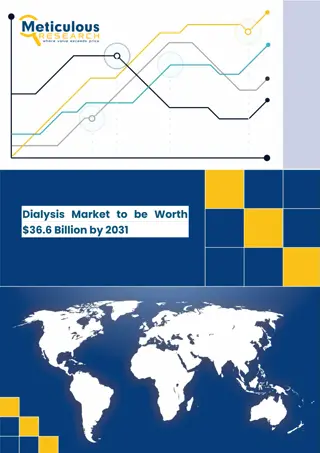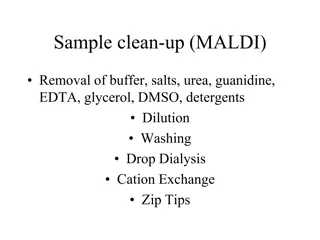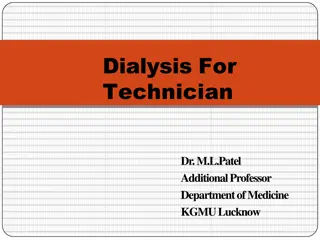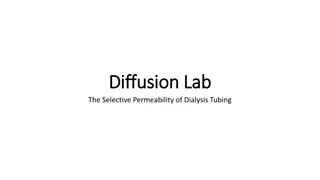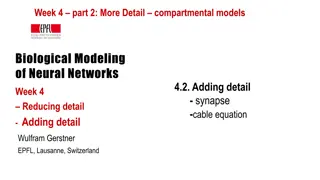Understanding Compartmental Model of a Dialysis Machine in Biomedical Engineering
Explore the compartmental models of a dialysis machine in the field of Biomedical Engineering, focusing on one- and two-compartmental models of haemodialysis. Learn how mathematical modeling aids in tailoring dialysis therapy to individual patient needs, and discover the different approaches to dialysis kinetic modeling, including the compartmental approach. Delve into the urinary system's role in urine production and the dialysis system's significance in renal replacement therapy. Additionally, uncover the concept of Urea Kinetic Modeling (UKM) for calculating dialysis efficiency.
Uploaded on Oct 10, 2024 | 0 Views
Download Presentation

Please find below an Image/Link to download the presentation.
The content on the website is provided AS IS for your information and personal use only. It may not be sold, licensed, or shared on other websites without obtaining consent from the author. Download presentation by click this link. If you encounter any issues during the download, it is possible that the publisher has removed the file from their server.
E N D
Presentation Transcript
COMPARTMENTAL MODEL OF A DIALYSIS MACHINE Presented by: Oyeboade R. Kiitan 17/eng08/004 Biomedical Engineering BME312 Biological system of control and Modelling 1
INTRODUCTION One- and two-compartmental models of haemodialysis (HD) are well known. These models make it possible to analyse the course of treatment and to predict the effect of dialysis procedures. Mathematical modelling helps physicians to match dialysis therapy to the individual needs of the patient; however, the efficiency of the models depends on the accuracy of the coefficients. 2
URINARY SYSTEM The urinary system, also know as the renal system, produces, stores and eliminates urine, the fluid waste execrated by the kidneys. The kidneys make urine by filtering wastes and extra water from blood. Urine travels from the kidneys through two thin tubes called ureters and fills the bladder. When the bladder is full, a person urinates through the urethra to eliminate the waste 3
DIALYSIS SYSTEM This is the process of removing excess water, solutes, and toxins from the blood in people whose kidneys can no longer perform these functions naturally. This is know as renal replacement therapy. There are 5 types of dialysis, three (3) primary and two (2) secondary, namely: Haemodialysis Peritoneal dialysis Hemofiltration Hemodiafiltration Intestinal dialysis 4
DIFFERENCE APPROACHES OF DIALYSIS KINETIC MODELLING In general, kinetics describe the variation over time of a physical entity (e.g. concentration, mass, energy) which is exchanged among different systems or in between a system and the environment. The human body can be considered as comprising of different anatomical compartments separated by semi-permeable membranes. 5
COMPARTMENTAL APPROACH TO DIALYSIS To mathematically describe these processes, the body can be divided into different compartments in which the physical entity of interest (e.g. concentration) is considered to assume the same value over the compartment volume. Compartmental models are used for solving the problem of the control of dialysis therapy. Impedance techniques allow to solve problem of measuring the total body water for each patient. 6
UREA KINETIC MODELLING (UKM) UKM is a method used to calculate haemodialysis and offers an opportunity to calculate the efficiency of a dialysis treatment The assessment of dialysis dose is based on clinical parameter; Kt/V where: K is the dialysis clearance t is the duration of dialysis V is the urea distribution volume at the end of dialysis A treatment is considered adequate if Kt/V achieved the minimum target of 1.2 7
SYSTEMATIC DIAGRAM OF MODELS One- compartmental model Two- compartmental model 8
ONE COMPARTMENTAL MODEL One- compartmental model visualised the body as one compartment. based on law of mass conservation, the rate of change of mass of the body fluid can be represented by a differential equation. (1) Which can be rewritten as (2) 9
ONE COMPARTMENTAL MODEL PARAMETERS where C(t) is the urea concentration (mg/ml) at time, t, V is the volume of solute distribution (ml) and G is solute generation rate (mg/min). K is the total clearance of urea (ml/min); K = Kr , between two dialysis and K = Kd + Kr , during dialysis. Kr and Kd are residual renal clearance and dialyser clearance, respectively. From Equation (2) C(t) and C(0) are urea concentration at any time, t and pre-dialysis urea concentration respectively. 10
TWO COMPARTMENTAL MODEL This reflect the urea movement into the extracellular pool rather than the intracellular pool. The intracellular urea flux is generated by a concentrated gradient at the cell wall. The gradient create urea movement between the intracellular and extracellular compartments. 11
The equations used to generate the computational model where, Kc = urea transfer coefficient (ml/min) Kd = dialyzer clearance (ml/min) Kr = kidney clearance (ml/min) Ve = extracellular compartment volume (ml) Vi = intracellular compartment volume (ml) Ce = extracellular urea concentration (mg/ml) Ci = intracellular urea concentration (mg/ml) Ceo = Ce at time zero - same as Predialysis BUN Value*100 Cio = Ci at time zero - same as Predialysis BUN Value*100 G = urea generation rate (mg/min) t = time (min) 12
REFERENCES Mariusz, Z., Jacek, A.P., & Joanna, G., (2000, March), Accuracy of hemodialysis modelling. Kidney International. 57(3), 1152-1163 Ahmad, N.S., Tamrin, & Ibrahim, N., (2014, November), Post-dialysis urea concentration: comparison between onecompartment model and two-compartment model. Journal of Physics Conference Series. 546(1). DOI: 10.1088/1742- 6596/546/1/012022 Sunny, E., Daniel S., & Raymond V., (2012, 24 August), What can the dialysis physician learn from kinetic modelling beyond Kt/Vurea? . Nephrology Dialysis Transplantation. 27(11), page 421-429 14



